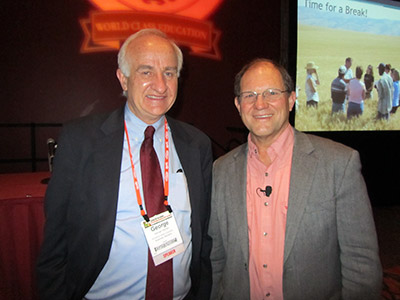How Do We Pass On the Ranch?
Cattlemen's College speakers offer tips for generational transfer.
SAN ANTONIO, Texas (Feb. 4, 2015) — George Haynes and Dick Wittman teamed up to share thoughts and experiences on succession planning for farm and ranch families during the 22nd annual Cattlemen’s College® Feb. 4 in San Antonio, Texas. The event was convened on the opening day of the 2015 Cattle Industry Conference & NCBA Trade Show.

George Haynes and Dick Wittman say communication is integral to the succession planning process.
Ninety percent of family businesses fail to pass to the third generation, reported Wittman as he addressed Cattlemen’s College attendees. With that sobering fact, he asked, “Is that destiny or a choice?
“You get to choose,” he said, encouraging those in family businesses to be proactive in working with family to establish a succession plan for the next generation. Involved in a family operation in Idaho, Wittman, who also works as a succession planning and business consultant, shared that his family is preparing for its 10th transition since 1980 to bring family members into the operation.
Wittman emphasized that communication among family members is integral to the succession planning process. To assist with that process — and understanding one another’s perspectives, he said it is important to have all stakeholders sit down together and ask questions. As an example, he suggested asking both the owners and the potential successors to complete this sentence: "If I go back to the farm/ranch, my expectations are …"
As the succession plan develops, he noted, “a decision is never truly made or committed to until it is written down on paper.”
Haynes, an extension economist with Montana State University, suggested the following steps as a guideline for the “stages” of transfer to the next generation:
• prebusiness or grunt work;
• education and personal development;
• proof of competence;
• a formal start; and, finally,
• a declaration of transition.
Once you get to the final step, Haynes told the older generation, “You better be willing to throw the reins.”
Wittman added that by doing the transition process in pieces and steps, it becomes more manageable and clarity evolves.
For families interested in learning more about the balance of family and business, Wittman recommended the book Perpetuating The Family Business: 50 Lessons Learned from Long Lasting, Successful Families in Business by John Ward.
Editor’s Note: The articles used within this site represent a mixture of copyrights. This article was written by staff or under contract for the Angus Journal. If you would like to reprint or repost this article, you must first request permission by contacting the editor at 816-383-5200; 3201 Frederick Ave., Saint Joseph, MO 64506. The Angus Journal claims copyright to this website as presented. We welcome educational venues and cattlemen to link to this site as a service to their audience.

